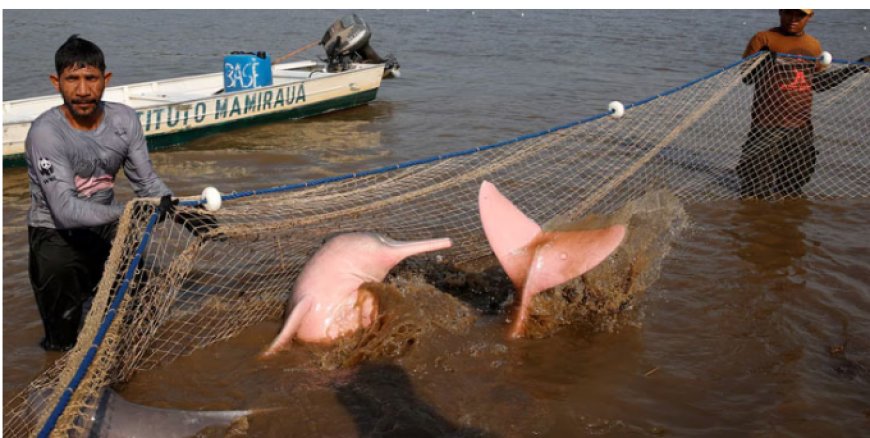Amazon dolphins studied for climate change impact

1. A team of biologists, vets and fishermen temporarily captured rare freshwater dolphins in the Amazon this week to study their health in hopes of avoiding a repeat of the deaths of hundreds of the mammals last year due to a severe drought.
The dolphins were brought ashore for blood tests and other examinations and then promptly returned to Lake Tefé in the Amazon basin. Researchers inserted a microchip to monitor their behavior via satellite.
Fishermen took care not to harm an adult female dolphin during the capture and kept her close to her calf to minimize stress.
“She relaxed, and we were able to perform all the tests. She seemed to be in good health,” said project leader Miriam Marmontel of the Mamirauá Institute of Sustainable Development, which organized the expedition to temporarily capture up to 20 dolphins.
The research involved taking a biopsy sample to check for contaminants in her blubber and placing a microchip on her back to track her movements, the depths she swims at, and even water temperatures remotely.
Last year’s record-breaking drought in the Amazon rainforest, partially driven by climate change, led to a grim discovery: more than 200 river dolphin carcasses were found floating on Lake Tefé, formed by a tributary of the Amazon River.
Researchers believe low river levels during the drought caused the water to heat to temperatures intolerable for the dolphins. Thousands of fish also died in Amazon waterways due to oxygen depletion.
**PINK DOLPHINS**
Amazon river dolphins, many of which are a striking pink color, are a unique freshwater species found only in South America’s rivers. Their slow reproductive cycles make them particularly vulnerable to threats.
Marmontel hopes to determine what caused last year’s dolphin deaths before the upcoming drought season begins, allowing researchers to respond more quickly.
“We aim to learn more about the dolphins’ health as water levels drop and temperatures rise so that we can identify whether the changes are due to higher temperatures or toxins or pollutants in the water,” she told Reuters.
The project received support from the National Marine Mammal Foundation of California, whose researchers conducted ultrasound examinations on the dolphins.
Marmontel noted that most of the dolphins that died last year were in Lake Tefé, a 45-km-wide (27-mile) body of water where dolphins are commonly found, just off the Solimões River.
During the 2023 drought, the lake’s water reached 40.9 degrees Celsius (105.62 Fahrenheit), more than 10 degrees above the average for that time of year. Currently, the water is at 30 degrees Celsius (86 degrees Fahrenheit), according to Ayan Fleischmann, a geosciences researcher at the Mamirauá Institute.
Environmental activists have blamed the unusual conditions on climate change, which is making droughts and heat waves more frequent and severe. However, the exact role of global warming in last year’s Amazon drought remains unclear, with other factors, such as the El Niño weather phenomenon, also likely playing a role.


















































